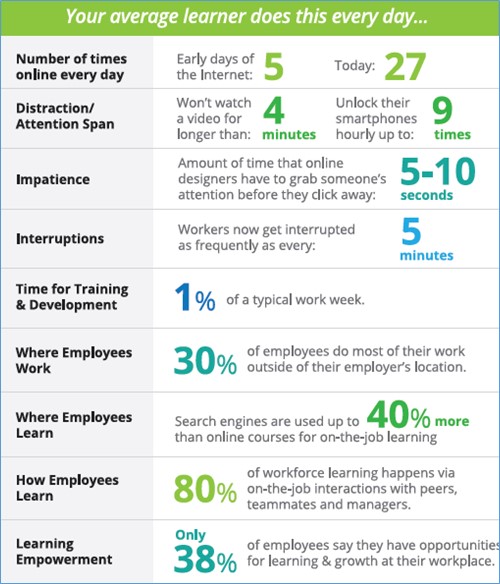Who is the Modern Corporate Learner?
Sarah Flesher
How do we improve the effectiveness of corporate learning? Before we can answer this question, we have to understand who our workforce is. The migration of millennials into the workforce has led to a rapid evolution over the last 10 years. This generational impact on learning requires Instructional Designers to rethink how they design content. Consider this: millennials have not known life without the Internet. Their enhanced ability to understand and use technology also opens the door for novel technological use in learning and development.
So, how do we improve corporate learning? How do we engage the younger workforce? Read on to discover who the modern corporate learner is, and how we can design learning that engages millennials.
Who is the Modern Corporate Learner?
Bryan Austin, in collaboration with Beyond.com, studied the differences between how millennials view themselves and how HR professionals and learning and development professionals view millennials. Their results in 5 key areas are summarized in the table below.

Source: Bryan Austin (2016). The Modern Corporate Learning. mLevel Inc.
The differences are quite striking, with very little alignment between the two perceptions. Millennials believe that they have good people skills, are loyal and have strong work ethics, while HR professionals have the opposite perception. This study highlights the disconnect between millennials in the workforce and HR Professionals. It is this preference in perception that Instructional Designers must bridge in order to design effective eLearning.
What Does the Average Learner do Every Day?
Not only has there been a generational shift in the workplace, but the behaviours and habits of learners have changed. Research conducted by Josh Bersin and Bersin by Deloitte highlights the characteristics of employees and how they function in todays workplaces. For example, today's employees are 'overwhelmed, distracted, and impatient'. Flexibility is important. Collaboration is important. Employees want more control over their own development.
The graphic below compares key characteristics relating to how employees function on a daily basis.

Source: Adapted from Josh Bersin and Bersin by Deloitte - Meet the Modern Learner - and Bryan Austin (2016) - The Modern Corporate Learning. mLevel Inc.
These findings bring with them a series of challenges. Instructional Designers are faced with requests to develop learning programs that are shorter and more concise. Learning "chunks" are becoming smaller and smaller because it's more difficult to engage learners given all of these distractions. Training needs to be flexible. Learners want to be able to learn on their own terms. Millennials are resourceful. They don't wait around to find answers and are quick to type their questions in to a search engine.
This new generation of workers values personalization and different learning styles. Employees are mobile and always on the go. They find themselves working from different locations and structuring their work days to accommodate their lifestyles. The current training and development landscape needs to adapt and address these challenges.
Designing & Delivering Content to Engage the Modern Learner
We've outlined who the corporate learner is. Now, how do we design and deliver content that addresses this demographic change?
Here are our top five suggestions.
1. Use Collaborative Learning and Social Media
Let's meet learners where they already spend a lot of their time: social media. Millennials rely on social media to share knowledge, ideas and discuss challenges. It's where they receive advice and feedback. By using forums and chats, you are using platforms that millennials are familiar with. Social media allows Instructional Designers to create virtual communities, and mirror in a work environment activities learners do on their own time.
Collaborative learning, and specifically online collaboration, enables people to connect and collaborate anywhere at anytime. Learning doesn't have to be formal. Informal learning or learning that is less structured appeals to the younger workforce because they appreciate the flexibility.
Millennials are accustomed to working in groups and teams. Most universities now incorporate group work into the majority of their classes. It is a natural progression for millennials to continue to collaborate with others once they move into the workforce.
Tips for designing a collaborative learning program:
- Set the context: introduce and familiarize learners with the collaborative nature of the learning program.
- Assign roles: help learners understand their role as participants and contributors.
- Develop a sense of community and shared purpose: the goal is to ensure all learners are comfortable contributing their ideas.
- Organize discussion topics and various collaborative activities.
- Provide feedback and reward learners: support collaboration and reward groups when they are engaged in a rich discussion.
2. Incorporate Gamification
Gamification is an effective method for learning because millennials are achievement-oriented. When game-like features are combined with relevant scenarios that learners typically face on-the-job, it serves as an effective strategy to motivate learners. By incorporating incentives and rewards in to your learning programs, learners receive immediate gratification through immediate feedback.
Gamification as a learning strategy is something that millennials are familiar with. The popularity of incorporating game-like features in K-12 and higher-education curriculums has exponentially increased. Additionally, millennials are big video game players. By incorporating these elements in to corporate learning programs, you are simply using strategies that younger learners are used to using.
Remember: Gamification doesn't have to be complex. Effective strategies include leaderboards, badges and incentives.
Tips for incorporating game-like features in to your learning programs:
- Before incorporating gamification, ensure you have clear learning goals and objectives.
- Design your game to motivate learners and drive positive behaviours.
- Incorporate a leaderboard that documents progress.
- Use levels or bring learners though a 'learning journey'.
- Ensure that you have incentives, rewards or a badge system.
- Create a collaborative environment using discussion groups and, when applicable, integrate with social media.
- Keep it simple and encourage learners to have fun!
3. Keep Learning 'Bite-Sized'
Although full day workshops and PowerPoint training sessions have their place in learning and development, research shows that micro-learning, or bite-sized learning, is just as effective. Research published in the Journal of Applied Psychology (2002), found that "bite-sized pieces makes the transfer of learning from the classroom to the desk 17% more efficient". Bite-sized learning focuses on one or two learning objectives. It allows learners to digest a small amount of information at a time. Therefore, learners aren't overwhelmed with too much information.
From a development perspective, micro-learning courses can be produced faster and at less cost than traditional courses. During your needs assessment, determine if one five-minute micro-learning activity will meet the needs of the learner. Consider using an assessment that uncovers any learning gaps. These gaps can be used to determine what learning pieces need to be developed.
Remember: Bite-sized learning is easily accessible and learners can take it at their own pace.
Tips for developing bite-sized learning content:
- Keep it short (3-7 minutes of content).
- Incorporate videos.
- Focuses on one learning objective at a time.
- If online, build in interactivity.
- Use case studies.
- Include a quick evaluation check or quiz.
4. Make Delivery Agile and Flexible
Agile learning refers to "any approach to content development that focuses on speed, flexibility and collaboration". We know that millennials are agile and flexible, so why not develop learning to align with these characteristics? Agile learning allows learners to get what they need and get back to work. You are giving learners instant access to learning that suits their needs and takes into account their existing knowledge.
Agile learning includes using tablets and smart phones. It means breaking down content into smaller, more digestible pieces. Instructional Designers need to embrace mobile learning and video-based learning. For millennials, having the ability to pull up a short video on their phone as they commute allows them to get the information they need without having to be in the office. Their ease with technology means that they respond well to a range of digital learning styles and delivery methods.
The whole point of agile design is to be adaptable to the circumstances in which it operates.
Tips for designing content that is agile and flexible:
- Identify a problem or knowledge gap and answer that problem.
- Use stories or simulated situation.
- Design content in bite-sized pieces.
- Focus on one learning objective at a time.
- Deliver content online.
5. Ensure Learning is Goal-Oriented and Challenging
Millennial learners like a challenge. A one size fits all mentality doesn't work because learners are goal-orientated. Traditional learning (i.e., sitting in a classroom) is less effective because learners care about getting the piece of information they need and moving on. Focus on competencies, not learning time. When a learner can demonstrate that they have the knowledge, or can demonstrate a required skill, reward them for that accomplishment. Evaluation of competencies is important. A simple test or skill check is an effective way to evaluate a learner.
When learning is challenging, your learners stay motivated. As soon as the content is too easy or not relevant, learners tune out. Having a documented standard or learning goal ensures that learners have something to work towards. It also ensures learners know what they will be evaluated on.
Tips for ensuring learning is goal-oriented and challenging:
- Write clear learning objectives.
- Design assessments and evaluation items that align with your learning objectives.
- Incorporate forum questions and discovery questions where learners need to search for answers. Don't just tell them.
- Use simulated-based learning strategies.
Conclusion
The five suggestions discussed here are just some of the ways you can begin to engage millennials. Hopefully, this list has provided you with some things to consider as you design learning content for a new generation of workers. There is no denying that a generational shift is occurring in our workforce, and this shift gives us and other Instructional Designers the opportunity to be innovative and improve corporate learning.
References:
-
The Modern Corporate Learning (article published by the Training Magazine)
-
Meet the Modern Learner from Josh Bersin and Bersin by Deloitte
📘 Ready to Elevate Your Learning Strategy?
Explore our comprehensive library of eBooks and tools on learning resource development, competency-based learning, and LMS implementation. Transform your training programs with insights from industry experts and practical templates.
Sarah Flesher
Sarah is an Instructional Designer at BaseCorp Learning Systems and is currently completing a PhD in Educational Technology. Her research focuses on implementing competency-based learning systems in all types of organizations. When she doesn't have her nose in a book you can find her at the gym, on the ice, on the ski hill, drinking wine or in a coffee shop … with her nose in a book.
